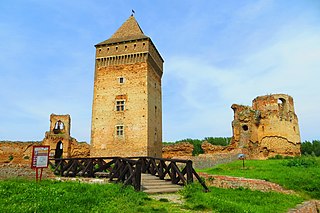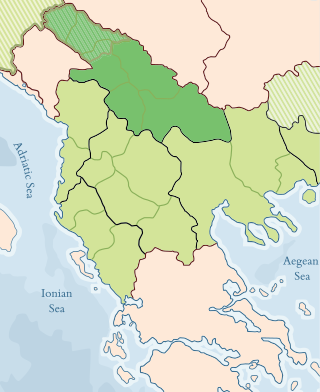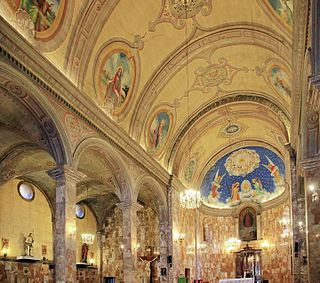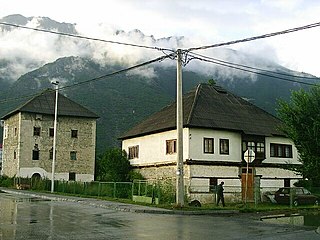Prizren is a city in Kosovo.
Prizren may also refer to:
Prizren is a city in Kosovo.
Prizren may also refer to:

Sremski Karlovci is a town and municipality located in the South Bačka District of the autonomous province of Vojvodina, Serbia. It is situated on the banks of the Danube, 8 kilometres from Novi Sad. According to the 2011 census results, it has a population of 8,750 inhabitants. The town has traditionally been known as the seat of the Serbian Orthodox Church in the Habsburg Monarchy. It was the political and cultural capital of Serbian Vojvodina after the May Assembly and during the Revolution in 1848.

An exarch was the holder of any of various historical offices, some of them being political or military and others being ecclesiastical.

Peja is the fourth most populous city in Kosovo and serves as the seat of the Peja Municipality and the District of Peja. It is located in the Rugova region on the eastern section of the Accursed Mountains along the Lumbardhi i Pejës River in the western part of Kosovo.

Prizren is the second most populous city and municipality of Kosovo and seat of the eponymous municipality and district. It is located on the banks of the Prizren River between the foothills of the Sharr Mountains in southern Kosovo. Prizren experiences an oceanic climate under the influence of the surrounding mountains.

Herceg Novi is a coastal town in Montenegro located at the Western entrance to the Bay of Kotor and at the foot of Mount Orjen. It is the administrative center of the Herceg Novi Municipality with around 33,000 inhabitants. The town was founded as a fortress in 1382 by the King of Bosnia, Tvrtko I Kotromanić, and named after Saint Stephen but the name did not stick, instead it became known as Novi (transl. New), also Castelnuovo in Italian. Between 1482 and 1687 it was part of the Ottoman Empire and then from 1687 to 1797 the Albania Veneta of the Republic of Venice. It was a Catholic bishopric and remains a Latin titular see as Novi. Herceg Novi has had a turbulent past, despite being one of the youngest settlements on the Adriatic. A history of varied occupations has created a blend of diverse and picturesque architectural style in the city.

Novo Brdo or Novobërda and Artanë, is a town and municipality located in the Prishtina district of Kosovo. According to the 2011 census, it has a population of 6,729 inhabitants. The center of the municipality is the village of Bostane. The region is especially known for its role in mining during medieval times, in particular after the construction of the Novo Brdo Fortress by Stefan Milutin to house Saxon miners who were brought in the region.

Bač is a town and municipality located in the South Bačka District of the autonomous province of Vojvodina, Serbia. The town has a population of 4,405, while the municipality has 11,431 inhabitants. The entire geographical region between the rivers Danube and Tisza, today divided between Serbia and Hungary, was named Bačka after the town.

Kyustendil is a town in the far west of Bulgaria, the capital of the Kyustendil Province, a former bishopric and present Latin Catholic titular see.

The Vilayet of Kosovo was a first-level administrative division (vilayet) of the Ottoman Empire in the Balkan Peninsula which included the current territory of Kosovo and the north-western part of the Republic of North Macedonia. The areas today comprising Sandžak (Raška) region of Serbia and Montenegro, although de jure under Ottoman control, were in fact under Austro-Hungarian occupation from 1878 until 1909, as provided under Article 25 of the Treaty of Berlin. Üsküb (Skopje) functioned as the capital of the province and the midway point between Istanbul and its European provinces. Üsküb's population of 32,000 made it the largest city in the province, followed by Prizren, also numbering at 30,000.

The Vilayet of Scutari, Shkodër or Shkodra was a first-level administrative division (vilayet) of the Ottoman Empire that existed from 1867 to 1913, located in parts of what today is Montenegro and Albania. In the late 19th century it reportedly had an area of 13,800 square kilometres.

The Diocese of Prizren and Pristina is a Latin Church ecclesiastical territory or diocese of the Catholic Church in Kosovo. It is centred in the city of Prizren. It was erected as an apostolic administration in 2000, after being split from the Diocese of Skopje and Prizren, and elevated to the rank of diocese in 2018.

The Catholic Church in North Macedonia is part of the worldwide Catholic Church, under the spiritual leadership of the Pope in Rome and is one of the major religious communities that exist on the territory of the Republic of North Macedonia. Catholic believers from North Macedonia mostly include Albanians, Macedonians and Croats and are most concentrated in the Skopje Statistical Region and the Southeastern Statistical Region of North Macedonia.
Kosovo was part of the Ottoman Empire from 1455 to 1912, at first as part of the eyalet of Rumelia, and from 1864 as a separate Kosovo Vilayet.
Term Diocese of Prizren may refer to:

The Diocese of Skopje, is a Latin Church diocese of the Catholic church in North Macedonia. From the 4th century to 1656, when it was renamed to Archdiocese of Skopje, it was known as the Archdiocese of Dardania. In 1969 along with the Roman Catholic Diocese of Prizren, it formed the Diocese of Skopje-Prizren. In 2000 it became a suffragan diocese of the Archdiocese of Vrhbosna, and the bishop is Kiro Stojanov, appointed in 2005.
Diocese of Skopje may refer to:

The Catholic Church has a population in Kosovo of approximately 65,000 in a region of roughly 2 million people.

The Sanjak of Prizren was one of the sanjaks in the Ottoman Empire with Prizren as its administrative centre. It was founded immediately after Ottoman Empire captured Prizren from Serbian Despotate in 1455. The rest of the territory of Serbian Despotate was conquered after the fall of Smederevo in 1459, and divided into following sanjaks: Sanjak of Viçitrina, Sanjak of Kruševac and Sanjak of Smederevo. At the beginning of the First Balkan War in 1912, the territory of Sanjak of Prizren was occupied by the army of the Kingdom of Serbia. Based on Treaty of London signed on 30 May 1913, the territory of Sanjak of Prizren became part of Serbia.
The Sanjak of Viçitrina, also known as the Pristina Pashaluk, was a sanjak of the Ottoman Empire in Rumelia, in present-day Kosovo. It was named after its administrative center Vučitrn.

Gusinje Municipality is a municipality in eastern Montenegro in the upper Lim valley at an elevation of about 1,000 m (3,000 ft). It was created in 2014, when it split from Plav Municipality. Its center is the small town of Gusinje, and its biggest village in terms of territory is Vusanje. Two of Montenegro's highest mountains overlook Gusinje: Zla Kolata and Visitor. Many of Gusinje's settlements are historically linked with the Albanian Kelmendi tribe (fis). The village of Gusinje developed into a town the 17th century around a fortress built by the Ottomans to contain the Kelmendi. In the 19th century, Gusinje was a developing regional market center. It was engulfed in 1879–1880 in a struggle between the Principality of Montenegro that wanted to annex it and the League of Prizren that opposed it. After the Balkan Wars, Gusinje became part of Montenegro and in 1919 part of Yugoslavia. Today, it is part of Montenegro since its declaration of independence in 2006.